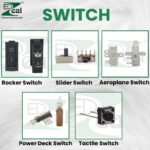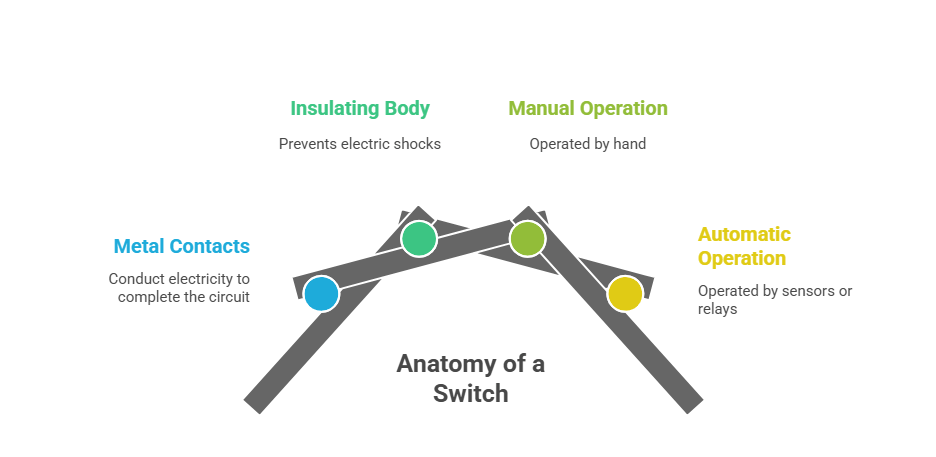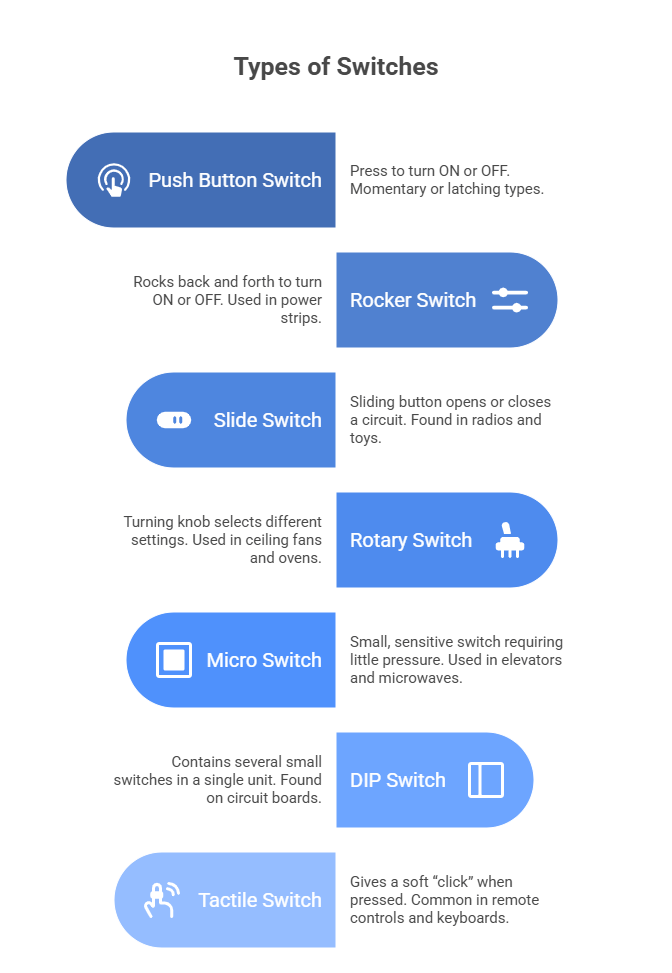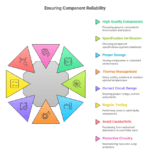Everything You Need to Know About Switches in Electronics

Understanding Electrical Switches: Types, Functions, and Importance
Switches are one of the most important parts of electronics. From simple household items like lights and fans to big machines in factories, switches help us control electricity easily and safely. Every time you press a button, flip a switch, or turn a knob, you are using a switch to control how electricity flows. In this blog, we’ll understand what switches are, how they work, the different types of switches, and where they are used — all in simple words.
What is a Switch?

A switch is a small device that is used to start or stop the flow of electricity in a circuit. It works just like a gate for electric current. When the switch is ON, electricity flows through the circuit and powers the device. When the switch is OFF, the circuit is open, and electricity stops flowing, so the device turns off.
You can find switches in almost every device around you — lights, fans, televisions, mobile phones, and even computers. They make it easy to control electricity without directly touching wires. This makes them convenient and safe for everyday use.
How Does a Switch Work?
The working of a switch is simple to understand. Inside every switch, there are metal parts called contacts. When you turn the switch ON, these metal contacts touch each other and complete the electrical path, allowing electricity to flow. When the switch is turned OFF, the contacts move apart, breaking the path and stopping the current.
The contacts are usually made of metals like copper, brass, or silver because these conduct electricity well. The outside body of the switch is made of plastic or another material that does not conduct electricity. This prevents electric shocks and keeps the user safe.
Some switches are operated by hand, like the ones we use in homes, while others work automatically using sensors or control systems in advanced machines.
Why Are Switches Important in Electronics?
Switches are important because they give us control over electrical and electronic devices. Without switches, we would have to connect and disconnect wires every time we wanted to use an appliance, which would be unsafe and inconvenient. A simple press, flip, or turn of a switch allows us to start or stop any device instantly.
Switches also make systems safer. They can break the flow of electricity during a fault, preventing damage or short circuits. In industries and machines, switches are also used in automation systems, where machines can start or stop automatically. Whether it’s your table fan at home or a large motor in a factory, switches are what make electrical control easy and safe.
Different Types of Switches

A push button switch is very popular and easy to use. You simply press it to turn something ON or OFF. There are two main types — momentary and latching. A momentary push button works only while you press it, like a doorbell. A latching one stays ON until you press it again, like the power button on a computer.
A rocker switch rocks back and forth. One side turns the device ON, and the other turns it OFF. These are used in power strips, lamps, and kitchen appliances. They are simple and reliable.
A slide switch has a small sliding button that moves from one side to another to open or close a circuit. You can find them in radios, toys, and battery-operated gadgets. They are small and easy to use.
A rotary switch works by turning a knob. When you rotate it, you can select different settings or circuits. It is used in ceiling fans, ovens, and audio devices where you can choose different speeds or modes.
A micro switch is a very small and sensitive switch that requires little pressure to work. It reacts quickly when pressed and is used in elevators, microwaves, and safety systems.
A DIP switch (Dual In-line Package switch) contains several small switches in a single unit. These are often found on circuit boards to set or change device settings.
A tactile switch, also called a tact switch, gives a soft “click” when pressed. These are common in remote controls, keyboards, and control panels. They are small but very important in electronic gadgets.
Finally, a power switch is used to turn the main power of a device ON or OFF. It is designed to handle high current and is found in almost all appliances, from TVs to industrial machines.
How to Choose the Right Switch
Choosing the correct switch depends on where you are going to use it. The first thing to check is whether your circuit runs on AC (Alternating Current) or DC (Direct Current), as some switches are made for one type only.
Next, check the voltage and current rating. If a switch cannot handle the required current, it may get damaged or cause a short circuit. You should also look at how many connections or poles the switch has. Common types include SPST, SPDT, DPST, and DPDT — each one allows different ways to control circuits.
Also, consider the size and durability. For small electronics, compact switches like tactile or slide types are best. For heavy-duty or industrial use, choose strong switches that can handle more power. Always buy good-quality switches made from safe and durable materials.
Applications of Switches
Switches are used in almost every place where electricity is present. At home, they control lights, fans, and electrical sockets. In cars and bikes, switches are used for headlights, horns, and indicators. In electronics, they are essential in computers, TVs, and mobile phones.
In factories, switches are used in machines for control and safety. For example, a limit switch stops a machine when a part reaches its end position. Hospitals use switches in medical devices to ensure safe and accurate operation. Even in communication systems, switches are used to manage connections and signals.
No matter the field — household, industrial, or electronic — switches are everywhere.
Maintenance and Safety Tips
Switches are small but need care for long life. Make sure the connections are not loose and the switch is not broken. Keep them away from dust and water, as these can damage the contacts.
If you notice sparks, heat, or flickering when using a switch, replace it immediately. Never touch or repair a switch when the power is ON. Always choose switches that match the voltage and current requirements of your device.
Good maintenance and correct usage keep switches working safely and efficiently.
Conclusion
Switches may look small and simple, but they are the heart of every electrical and electronic system. They allow us to control electricity safely and easily in our daily lives. Understanding how switches work and knowing about their types helps you select the right one for your device or project.
From the tiny button on your remote to the large switch on industrial equipment, each switch plays an important role in making our world work smoothly. So, the next time you flip a switch, remember — this small device is what brings your electronics to life!



